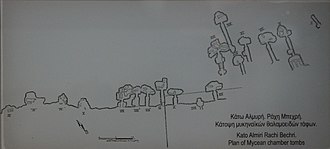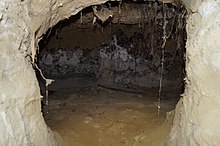Mycenaean cemetery of Kato Almyri
The Mycenaean cemetery of Kato Almyri ( Greek Μυκηναϊκό Νεκροταφείο της Κάτω Αλμυρής ) is located on the northern slope of the Bechri hill on the western edge of the Greek town of Kato Almyri in the Corinthian municipality of Saronikos. So far 21 Mycenaean chamber tombs have been discovered here.
discovery
In 1980 the Greek Archaeological Service undertook emergency excavations under the direction of the archaeologist Anna Banaka-Dimaki ( Greek Άννα Μπανάκα-Δημάκη ) after some graves had been partially destroyed by construction activities. 19 chamber graves from the Middle Mycenaean period were discovered. A year later, the area on Bechri Hill around the graves was declared an archaeological protection zone. Another grave was uncovered in 1991 by the archaeologist Zoe Aslamatzidou-Kostourou ( Greek Ζωή Ασλαματζίδου-Κωστούρου ). The last known grave was explored in 2006-2007 by the archaeologist Christos Vasilopoulos ( Greek Χρήστος Βασιλόπουλος ). Finds are exhibited in the Archaeological Museum of Isthmia .
history
The cemetery comes from the late Helladic period (SH III A – SH III B; 14th – 13th centuries BC) and was used for burials until SH III C late (1st half of the 11th century BC). After that, use is canceled. It is about the necropolis of Vagia or a previously unknown coastal town. In the 5th century BC Individual graves were used again for burials.
description
The eastern end of the cemetery is about 120 m west of the Metastaseos tis Theotokou church. From here it extends on the steep, wooded slope of the Bechri Hill about 100 m to the west. The graves were carved into the soft, white rock. They consist of a so-called dromos , i.e. a corridor with inwardly sloping side walls, an entrance and the burial chamber. Access here was always from the north. The Dromoi are between 1.50 m and 9 m long and about 1 m wide and some had side niches. Some side niches were closed with dry stone walls. At the end you reach the entrance, which was between 0.80 m and 1.10 m high. The floor of the dromoi is usually lower than that of the entrance and the chamber. The burial chambers were between 2 m and 6 m wide. All but one of them collapsed today. One or more grave shafts were found in some chambers. They were rectangular with rounded corners and with a lowered edge so that the cover plates were at ground level. These cover plates were made of alum slate or mudstone . The primary burials were simply placed on the chamber floor.
These were family graves in which one could prove at least two burials each. Presumably, the graves are to be grouped into two groups of graves that followed one another in time.
Grave I.
Grave I is the westernmost of the graves excavated in 1980. It only consists of a 4 m long drom with a side niche. Presumably it was discovered during the construction that the subsoil was not suitable for the construction of an underground burial chamber, and therefore the work was discontinued.
Grave II
Grave II is about 10 m east of grave I. The 5.50 m long dromos has a side niche and side walls that converge steeply upwards. The burial chamber measures about 4 × 4 m and has three grave shafts.

Grave III
The dromos of grave III, which is roughly in the middle of the cemetery, is 4.50 m long and 0.80 m wide. The chamber is about 3 m wide and 2.50 m deep and has a niche in the right rear wall. There are a total of three grave shafts. A burial could be clearly proven in the shaft in the side chamber.
Grave IV
Grave IV is in the eastern part of the necropolis. Only the rear part of the approximately 2.5 m wide burial chamber has been preserved. Both the front part and the entrance and the drom have disappeared today. There are six grave shafts in the chamber.
Grave v
4 m west of grave IV is grave V. Of this, only the rear part exists today. The burial chamber was about 3.50 m wide and had three grave shafts and another in a niche in the back wall. Cover plates for the shafts were found in situ here. A burial could be proven in a shaft.
Grave VI
Also of grave VI, which is about 4.50 m west of grave IV, only part of the chamber has been preserved. It was about three feet wide. But it had a side chamber about 2.50 m wide. A large and a small grave shaft were found in the main chamber. It is the only chamber in the cemetery whose floor has not been leveled. Four ceramic vessels, three prochoes and a flip-top jug were placed symmetrically around the primary burial in the ground .
Grave vii
Grave VII is located 5 m east of grave II. It has a 5.50 m long dromos. The chamber is about 4 m wide and 3 m deep and has three grave shafts.
Graves VIII, VIII 1 and VIII 2
Graves VIII, VIII 1 and VIII 2 are adjacent graves, each with a separate drom, but the chambers are connected. They are located east of grave III. Tomb VIII has the shortest dromos at 1.50 m. There is a niche to the left and right of the dromos. It is one of the few graves where the lintel has been preserved. Seven grave shafts were found within the 4.50 m wide and 4 m deep burial chamber. Both the primary burial, which was placed on the ground, and a burial in the shaft in the eastern niche could be detected. Six clay vessels were found as grave goods.
The chamber of grave VIII 1 borders grave VIII in the west. The dromos is about 3 m long and has a side niche. The lintel has also been preserved here. There are two grave shafts in the only 2.50 × 2.50 m chamber.
In the west, grave VIII 2 is connected to grave VIII 1 . It has a 3 m long dromos and there are three shafts in the 4 × 2.50 m chamber.
Grave IX
Tomb IX is the most easterly tomb. It is the most destroyed. Only about half of the burial chamber is preserved. Dromos and entrance are completely missing. The grave was about 4 m wide and a burial could be proven in the shaft in the niche in the back wall.
Grave X
Grave X is 2.50 m west of grave III. It has a dromos 2.50 m long and 1.10 m wide. The chamber is 4 m wide and only 1.50 m deep. The original ceiling height can be deduced from tool marks on the wall. A body had been buried on a gravel bed on the floor.
Grave XI
The dromos of tomb XI, which is about 5 m east of tomb VII, is 4.50 m long and has a side niche. Bones without grave goods were found in this niche. Grave XI is the only grave in which the chamber ceiling is still intact. The 3 × 2 m chamber has no grave shafts. Several burials were found scattered across the chamber floor.
Grave XII
Grave XII is neither shown on the site plan nor mentioned in the archaeologist's publication.
Grave XIII
Grave XIII has a 6.20 m long drom with four side niches. Two of these niches are opposite each other. Bones without grave goods were also found in these niches. The lintel of the entrance is only partially preserved. The chamber with a cloverleaf-shaped floor plan has a width of 6 m and a depth of 4 m including side chambers. Here a primary burial was found on the ground. In the 10 grave shafts, further burials and in some cases also the cover plates of the shafts were found in situ. The remains of an incomplete corpse burn were found in a side chamber .
Grave XIV
The 2.80 m long dromos of grave XIV has steeply converging side walls. The entrance was stabilized by a border with stone slabs and the lintel is therefore partially preserved. The chamber is almost round with a diameter of about 3 m. A primary burial was found on the ground and another in the single grave shaft. A corpse was placed on a low landing of 0.75 × 1.80 m and a height between 0.05 m and 0.22 m. The grave goods consisted of a Prochous, an amphora and a one-handled beaker.
Grave XV
The 2.50 m long dromos of grave XV also converges steeply upwards. In the 5 × 2.50 m large chamber a body was found on a thin layer of gravel and two grave shafts. 788 intact and 34 broken pearls were discovered under an overturned beaker and eleven sphondylioi made of steatite as grave goods .
Grave XVI
Tomb XVI has the longest drom with a length of 9 m. The chamber is 3.50 m wide and 3 m deep and has a grave shaft.
Grave XVII
When grave XII was discovered, only 1 m of the drom was left. At 2.50 × 2 m, it has the smallest burial chamber of the 19 graves discovered first.
Grave XX
Grave XX was only discovered in 1991. The name deviated from the count of the archaeologist Banaka-Dimaki, who only assigned one number to the three connected graves. The grave is 70 m southwest of grave I. The dromos has been largely destroyed and the ceiling of the chamber collapsed. The small grave was 2.50 m wide, 1.75 m deep and 0.70 m high. At the first burial the body was placed on the floor. As accessories he had a pressed-flat alabastron and an unpainted one-handled mug. The grave was probably built in the 5th century BC. Used again for burial, because three unadorned lekythoi and a black oinochoe with fluting from the last quarter of the 5th century BC were also found here. Chr.
Grave XXI
In 2006, grave XXI was discovered 10 m north of grave VI. The width of the 8.40 m long dromos increases from the beginning of 0.95 m to the entrance to 1.30 m. The burial chamber is 3.40 m wide and 3.65 m deep. Four grave shafts were found. More were found around the primary burial on the ground in the chamber.
Finds
A total of 367 clay vessels, 14 clay figures, eleven of the psi and phi types, a female figure sitting on a throne and two animals, five seal stones , eleven sphondylioi carved from steatite, over 800 pearls, a bronze spearhead were found in the first 19 graves , a bronze ring, a bronze needle and a ribbon-shaped bronze sheet.
literature
- Konstantinos Kissas: Ancient Corinthia. Athens 2013, ISBN 978-960-6849-37-4 , pp. 86-87
- Anna Banaka-Dimaki: Κάτω Αλμυρή. in Αρχαιολογικὸν Δελτίον (Archaiologikon Deltion) , Volume 35 B1, 1980, pp. 102-105
- Konstantinos P. Theodoridis: Μυκηναϊκή Κορινθία , Ioannina 2014, pp. 62–63, 221–224 ( online )
Web links
Individual evidence
- ↑ Ministerial Decision No. ΥΑ ΥΠΠΕ / ΑΡΧ / Α1 / Φ04 / 311/16 / 26-1-1981 - ΦΕΚ 124 / Β / 2-3-1981
- ↑ Zoe Aslamatzidou-Kostourou: Κάτω Αλμυρή. Οικόπεδο Ιω. Τσάλη. in Αρχαιολογικὸν Δελτίον (Archaiologikon Deltion) , Volume 46 B1, 1991, pp. 106-107
Coordinates: 37 ° 50 ′ 47.6 " N , 22 ° 59 ′ 52.7" E






